Scalpel blade types play a critical role in surgical procedures, offering precise cutting solutions tailored to specific tasks. These blades, mounted on compatible scalpel handles, come in a variety of shapes and sizes, such as the widely used No. 10, 11, 12, and 15 blades.
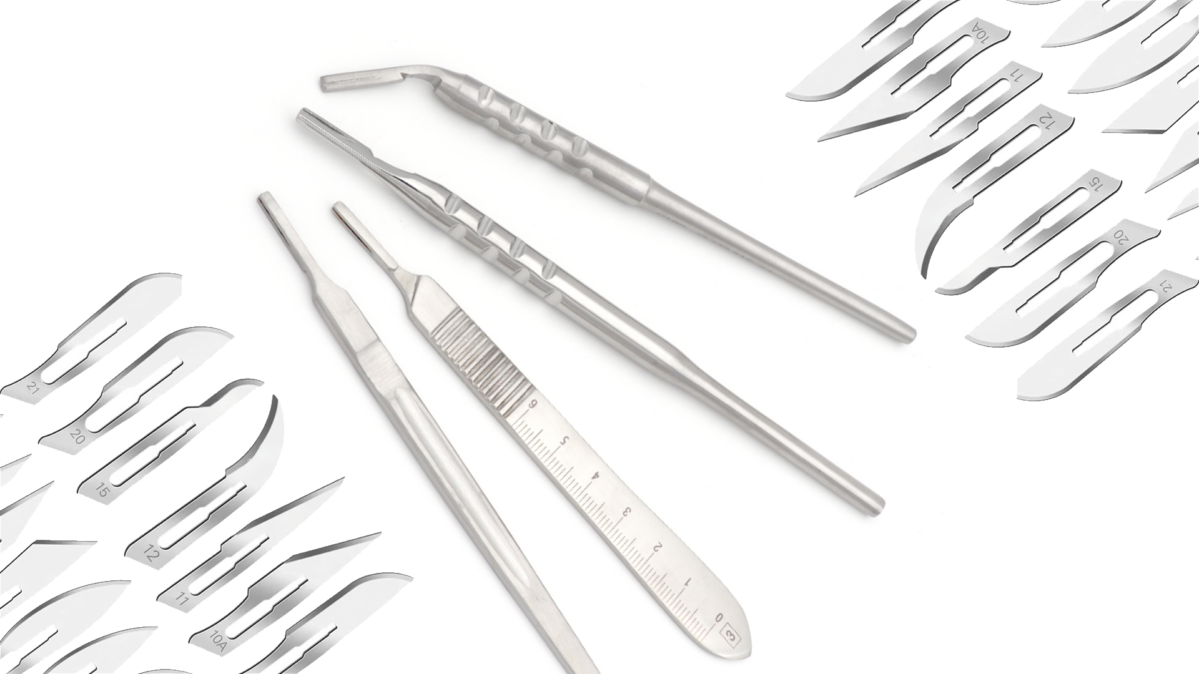
Each scalpel blade type is designed to meet the needs of diverse surgical specialties, from general surgery to delicate microsurgical applications. In this guide, we’ll explore the most common scalpel blade types, their unique features, and their practical uses in the operating room.
Contents
Standard Scalpel Blade Types
No. 10A Blade
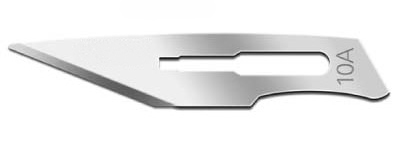
- Shape: Curved cutting edge with a pointed tip.
- Use: Ideal for making large incisions in skin and muscle, often used in general surgery and autopsies.
No. 11 Blade
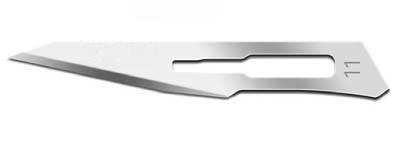
- Shape: Elongated triangular blade with a pointed tip.
- Use: Used for precise, stab incisions, such as creating entry points for laparoscopic ports or punctures in abscess drainage.
No. 12 Blade
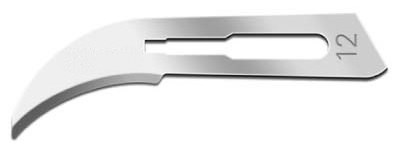
- Shape: Curved, sickle-shaped blade with the cutting edge on the inner side.
- Use: Commonly used in ENT (Ear, Nose, and Throat) surgeries, particularly for procedures like tonsillectomies or parotid surgeries.
No. 15 Blade
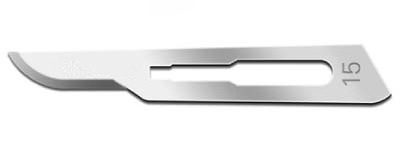
- Shape: Small, curved blade with a pointed tip.
- Use: Excellent for fine incisions and precise dissection, often used in plastic surgery, vascular surgery, and minor procedures.
No. 15C Blade
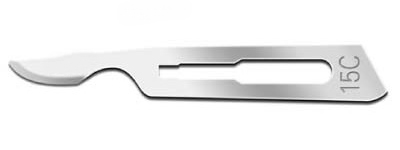
- Shape: Similar to the No. 15 but with a more pronounced curve for greater control.
- Use: Designed for delicate surgeries requiring enhanced precision, such as ophthalmic or microvascular procedures.
No. 20 Blade
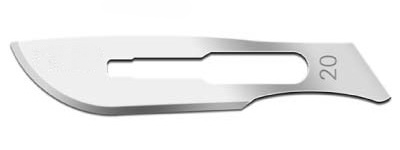
- Shape: Large, broad blade with a curved edge.
- Use: Suitable for large, deep incisions in thick tissues, often used in orthopedic and cardiothoracic surgeries.
No. 21 Blade
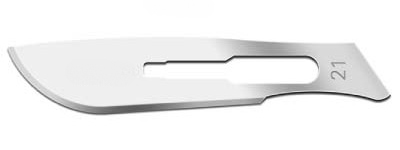
- Shape: Similar to the No. 20 but slightly larger.
- Use: Preferred for larger or deeper incisions in surgeries requiring extended reach.
No. 22 Blade
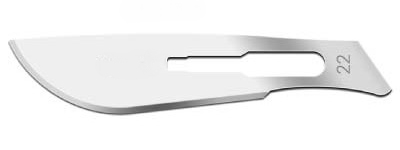
- Shape: Larger, curved blade with a pointed tip.
- Use: Often utilized in general surgeries and autopsies for large dissection work.
No. 23 Blade
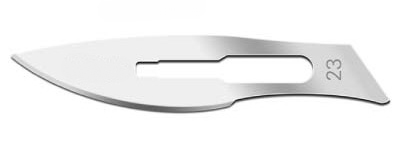
- Shape: Broad, spear-shaped blade with a sharply curved cutting edge.
- Use: Commonly used for long incisions, particularly in surgeries involving the abdomen or thorax.
No. 24 Blade
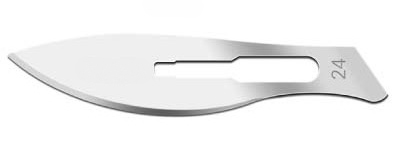
- Shape: Similar to No. 23 but with a more rounded profile.
- Use: Ideal for incisions in areas with soft tissues, such as gynecological and obstetric surgeries.
Specialty Blade Types
Stitch Cutter Blade
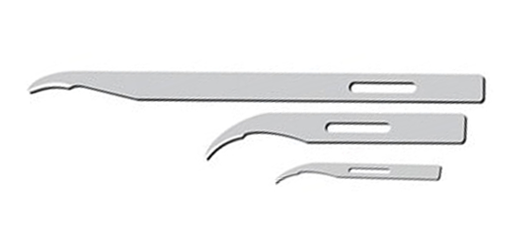
- Shape: Hook-shaped blade with a pointed tip.
- Use: Designed to cut sutures safely without damaging surrounding tissues, used in post-operative care.
No. 25 Blade
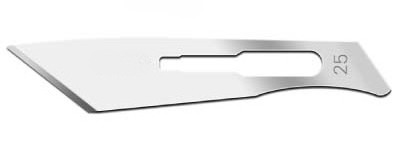
- Shape: Long, narrow blade with a straight edge.
- Use: Frequently used for delicate dissections or cutting in confined spaces.
No. 15T Blade
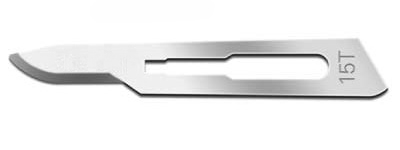
- Shape: Modified No. 15 blade with a thinner profile.
- Use: Suited for precise work in confined areas, often used in dermatological procedures.
No. 11P Blade
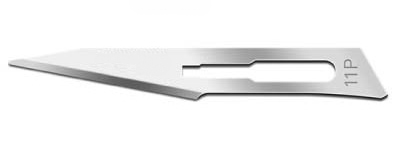
- Shape: Similar to the No. 11 but with a reinforced point for stability.
- Use: Used for puncture incisions where extra control is needed.
Micro Blades
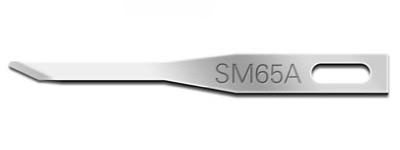
- Shape: Extremely small, fine-tipped blades.
- Use: Reserved for microsurgeries, such as ophthalmic or neurosurgical procedures.
Scalpel Handle Compatibility
Choosing the correct scalpel handle is just as important as selecting the right blade, as it ensures proper fit, control, and ease of use during surgical procedures. Scalpel handles come in different sizes and designs to accommodate specific blade types and surgical needs.
No. 3 Handle

This is the most commonly used handle for smaller, precision blades. It is compatible with blades such as Nos. 10, 11, 12, 15, and 15C, making it ideal for delicate surgeries like vascular, plastic, or general soft tissue procedures. The No. 3 handle is a standard choice in many operating rooms due to its versatility and compatibility with a wide range of blade sizes.
No. 4 Handle

Slightly larger and sturdier than the No. 3 handle, this handle is designed for use with larger blades, such as Nos. 20, 21, 22, 23, and 24. It is commonly used in surgeries requiring larger incisions, such as orthopedic or abdominal procedures. The robust construction of the No. 4 handle allows for better control when working with thicker or tougher tissues.
Specialty Handles:
These are designed to meet specific surgical requirements.

- Micro-Scalpel Handles: Extremely fine and lightweight, these handles are used for microsurgery, such as ophthalmic or neurosurgical procedures, where precision and minimal hand movement are critical.
- Ergonomic Handles: Designed to reduce hand fatigue during long surgeries, these handles often feature textured grips and an ergonomic shape.
- Handles for Specialty Blades: Certain handles are designed exclusively for blades like stitch cutters, providing better control and reducing the risk of accidental injury during suture removal or other post-operative tasks.
Each scalpel handle is meticulously crafted to provide a secure fit for its compatible blades, ensuring safety and efficiency during surgical procedures. Matching the right handle with the appropriate blade enhances the surgeon’s ability to perform with precision and confidence.
Choosing the Right Blade
Selecting the appropriate scalpel blade is a critical decision that impacts the success of a surgical procedure. While many blades may seem similar at first glance, their design and functionality vary significantly, making it essential to choose the right one for the task at hand. Here are the key factors to consider:
1. Procedure Type
The type of surgical procedure heavily influences the choice of blade. Different blades are designed to meet the demands of specific surgeries:
- Precision Work: Smaller blades like the No. 15 or 15C are ideal for fine, detailed incisions, making them popular in plastic surgery, vascular procedures, and ophthalmology.
- Large Incisions: Broader blades such as No. 10, 20, or 22 are suited for creating long or deep incisions in general surgery, orthopedics, or autopsies.
- Specialty Procedures: Curved blades like the No. 12 or specialty blades like stitch cutters are used for niche tasks, such as suturing removal or accessing hard-to-reach areas.
2. Tissue Type
The texture, thickness, and sensitivity of the tissue being operated on are crucial considerations:
- Thick or Dense Tissue: Large, sturdy blades like No. 20 or 22 are more effective for cutting through thicker tissues such as muscle or fibrous layers.
- Delicate or Thin Tissue: Smaller, curved blades like No. 15 or No. 11 are preferable for thin or sensitive tissues, reducing the risk of unintended damage.
- Hard-to-Reach Areas: Specialty blades, such as the No. 12, allow for precise cuts in tight spaces or curved areas, often required in ENT or urological surgeries.
3. Surgeon Preference
Personal preference plays a significant role in blade selection, often dictated by a surgeon’s training and familiarity with certain types of blades. Key considerations include:
- Comfort and Control: A surgeon might prefer a specific blade shape that offers better grip and maneuverability for their technique.
- Experience: Some surgeons are more adept at using specific blade types due to their consistent success in achieving the desired outcomes with those blades.
- Handle Compatibility: Certain scalpel handles (e.g., No. 3 vs. No. 4) are designed for specific blade sizes, which may influence a surgeon’s choice based on their preferred handle and setup.
Additional Considerations
- Patient Factors: Conditions such as scarring, adhesions, or pre-existing injuries may dictate the need for specialized blades.
- Surgical Environment: In fast-paced or emergency settings, a universally versatile blade like No. 10 might be chosen for efficiency and adaptability.
By carefully evaluating these factors, surgeons can ensure optimal performance, safety, and precision during procedures, resulting in better outcomes for patients.
Blade Materials and Handling
Surgical blades are crafted from high-grade materials, primarily stainless steel or carbon steel, to ensure exceptional sharpness, precision, and durability during use. Stainless steel blades are resistant to corrosion and are preferred in procedures requiring a sterile environment over extended periods. Carbon steel blades, on the other hand, are renowned for their razor-sharp edges, making them ideal for precise cuts, although they may require more careful maintenance to prevent rusting.
Proper handling of surgical blades is essential to maintain sterility, ensure safety, and prevent accidents. This includes:
- Safe Loading: Blades should always be mounted on scalpel handles using a designated blade holder or forceps to avoid direct contact with the sharp edge.
- Disposal: Used blades must be disposed of in puncture-proof sharps containers to prevent injuries and contamination.
- Sterilization: If using reusable handles or non-disposable components, strict adherence to sterilization protocols is necessary to maintain a sterile surgical field.
By following these practices, healthcare professionals can maximize the effectiveness of surgical blades while minimizing risks to both patients and staff.
Conclusion
Understanding the different types of surgical blades, their applications, and how they interact with compatible scalpel handles is crucial for achieving efficiency, safety, and optimal outcomes in surgical procedures. Each scalpel blade type is meticulously designed to meet specific surgical needs, from broad, sweeping incisions in general surgery to precise, delicate cuts in microsurgery. Selecting the appropriate blade is not just about choosing the right size or shape—it involves considering the type of procedure, the nature of the tissue, and the surgeon’s preferences.
Equally important is pairing the blade with a compatible handle that offers the necessary control, comfort, and precision. The No. 3 and No. 4 handles serve as versatile options for most standard blades, while specialty handles provide ergonomic solutions for unique surgical tasks. Proper blade materials, such as stainless steel or carbon steel, enhance durability and sharpness, while safe handling practices maintain sterility and reduce risks to both patients and medical staff.
By combining knowledge of scalpel blade types, thoughtful blade selection, and rigorous handling protocols, surgeons can optimize their techniques, minimize tissue damage, and ultimately improve patient outcomes. Whether in a high-stakes operating room or a routine clinical setting, the mastery of these tools underpins the success of every surgical endeavor.
For further reading see World Precision Instruments’ video: How to Choose a Scalpel Blade for Your Application




0 Comments